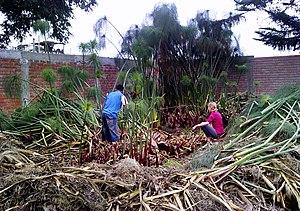
For common household greywater filtration an acceptable rule of thumb for designing constructed wetlands would be roughly 25 square feet per fixture (sink, tub, washing machine, etc). The most commonly accepted system is known as a "subsurface wicking system" meaning the flow of greywater is below the exposed surface of the wetlands. Typically the botanical cell is lined with an EPDM liner or in some cases a layer of bentonite clay, a bed of large rock (4"+) is laid out at the bottom of the wetland, this is covered by a layer of smaller gravel (3/8" - 3/4"), this is covered with a filter fabric which is covered with a layer of sand; ultimately this is covered with a layer of growing media and filled with plants. Many greywater wetlands are used for the production of food-bearing plants; it is recommended that plants used for food production are secondary producers such as tomatoes, bananas, peppers, etc and not plants whose foliage and roots are eaten such as lettuce or radishes.
See (and maybe combine into) Subsurface flow constructed wetland for greywater for more information.